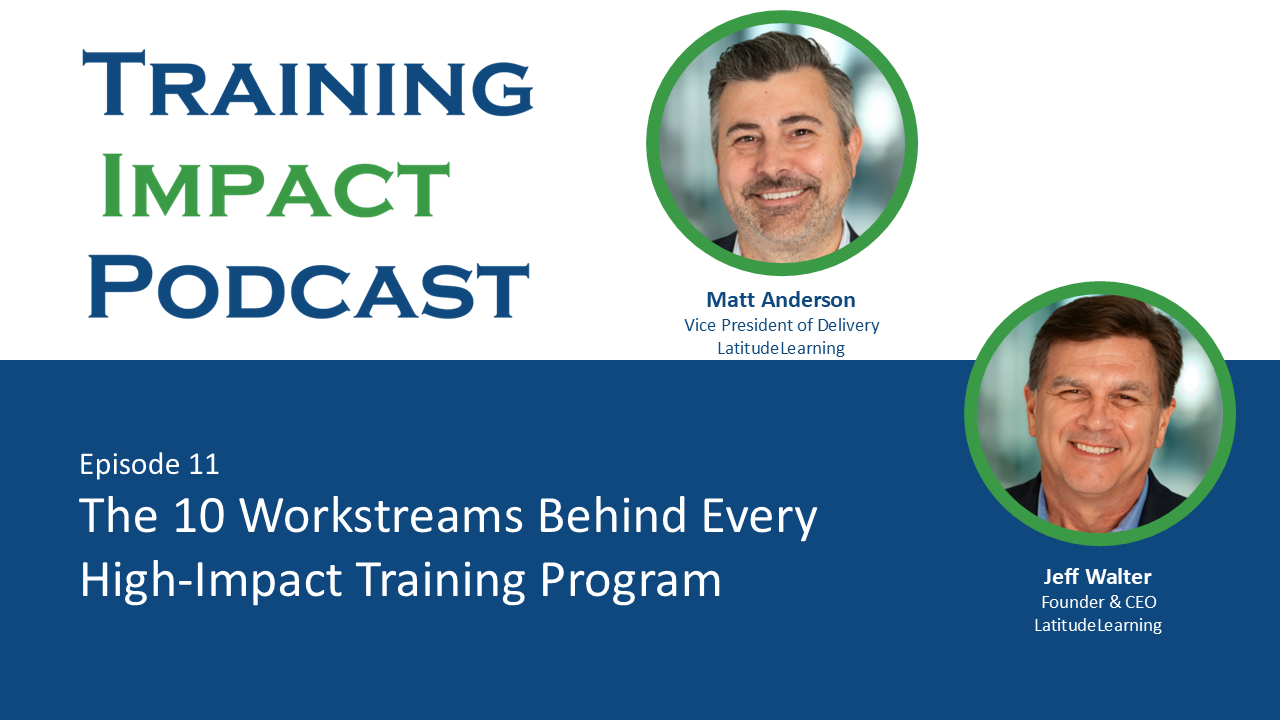
Ask anyone who’s tried to implement a training program at scale—especially in a fast-moving franchise environment—and they’ll tell you: the challenge isn’t just creating the content. It’s building a system that consistently delivers it, tracks progress, adjusts over time, and keeps people engaged.
That’s exactly what this episode of the Training Impact Podcast dives into.
Host Jeff Walter sits down with Matt Anderson, a 20-year training systems expert and head of delivery at LatitudeLearning, to unpack what really goes into launching and maintaining a successful training program. Spoiler alert: it’s not just about putting courses on a platform.
Instead, Matt shares the framework behind the scenes: the 10 Training Workstreams that drive sustainable, scalable learning.
Over the past two decades, Matt has seen it all—from employee training programs for global brands to partner enablement platforms for franchise systems. His background in software development, project management, and customer onboarding gives him a unique perspective on what separates a good training program from one that actually moves the needle.
As head of LatitudeLearning’s Delivery team, he oversees everything from new client implementations to system upgrades. In short, Matt is the person who turns ideas into fully operational training programs—and keeps them running.
You’ve mapped out learning goals. You know who needs to be trained. You’ve even got some great content in hand.
Now what?
That’s where the 10 Training Workstreams come in.
Matt and Jeff break these into three categories:
This is the foundation—where you make decisions that will impact every aspect of your training program going forward:
Organizing Learners – Are you structuring your users by job role, partner location, or skill level? If you’re supporting franchisees or dealers, can your system support multiple org structures?
Organizing Training Content – It’s not just about uploading courses. It’s about grouping, tagging, and packaging content in a way that’s easy to manage and intuitive for learners.
Designing the Learner Experience – From branded portals to mobile-friendly layouts, the learner experience plays a huge role in engagement and adoption.
These are the day-to-day mechanics that keep things running:
Creating and Updating Content – Thanks to tools like AI-generated video and rapid authoring platforms, this is getting easier. But consistency and accuracy still require human strategy.
Managing Learner Access – Will you add users manually? Use data feeds? Allow self-registration? Especially in partner networks, delegating access to the right managers can be a game-changer.
Assigning Training – Whether it’s self-enrollment, rule-based automation, or manager assignment, how you push training out matters.
Tracking Progress – Dashboards, reports, and alerts help you stay ahead of compliance issues and spot performance gaps.
This is where you go from “operational” to “impactful”:
Rewards and Recognition – In employee training, rewards might be tied to performance reviews. In partner training, they might include certification benefits or pricing discounts.
Measuring Success – Enrollment numbers and completion rates are nice, but Matt challenges organizations to look deeper. Are you improving KPIs? Driving sales? Reducing support calls?
Continuous Improvement – Training programs can’t be “set it and forget it.” Ongoing feedback, usage data, and business results should inform regular updates.
Matt’s core message is clear: if you want training that scales, you need to treat it like an operational system. That means thoughtful setup, regular management, and clear alignment with business goals.
This is especially true for franchise leaders and training managers trying to maintain consistency across decentralized teams. With turnover, shifting product lines, and multiple learner types, you simply can’t afford a fragile or patchwork approach.
As Matt says, “The more thought you put into these workstreams up front, the smoother your launch—and the easier your life becomes in the long run.”
Whether you’re building a new program from scratch or trying to fix one that’s gone off-track, this episode is your blueprint.
✅ Listen to the full episode of the Training Impact Podcast featuring Matt Anderson
🎙️ 11. The 10 Workstreams Behind Every High-Impact Training Proram
From LMS configuration to day-to-day operations to long-term strategy, Matt delivers a masterclass in what it really takes to deliver meaningful, scalable training.
Don’t miss it. Your next successful training program starts here.
—
Jeff Walter
Host, Training Impact Podcast
Founder & CEO, LatitudeLearning